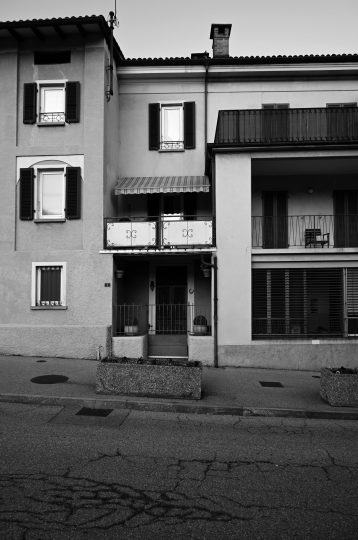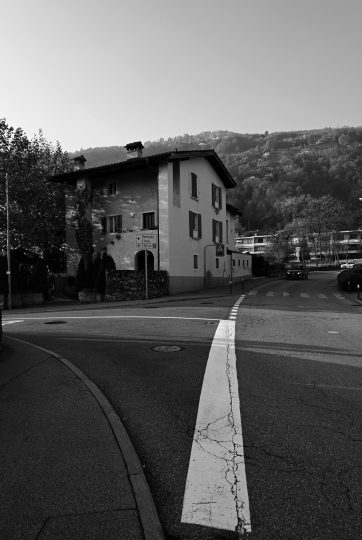本文由 enrico sassi architetto 授权mooool发表,欢迎转发,禁止以mooool编辑版本转载。
Thanks enrico sassi architetto for authorizing the publication of the project on mooool, Text description provided by enrico sassi architetto.
enrico sassi architetto:该项目重新定义了受“卡德马里奥大道”轴线改造所影响的公共空间;这条道路连接着瑞士比奥焦市的历史中心,将重要的 Strada Regina 街道(Lugano – Ponte Tresa 连接线)与 Malcantone 市连接起来。
该干预措施包括一系列公共空间的重新连接/改造项目,与穿越核心区域的州级公路更新同步进行,总长度为185米。该项目涵盖了所有用于行人通行的空间,从下游的市政“门户”(带喷泉和绿地的区域)开始,然后是与之重新连接的“广场花园”、公共交通站点,最后到上游的市政厅建筑的入口。人行道铺设了不同类型的天然石材(1100平方米),新建了绿地(128平方米),并建造了一个带瀑布的喷泉(31平方米)。
enrico sassi architetto:The project redefines the public space affected by the redevelopment of the road axis of “via Cademario”; a road link that crosses the historic center of Bioggio connecting the important road of the Strada Regina (Lugano – Ponte Tresa connection) with the above Malcantone municipalities.
The intervention consists of a series of public space reconnection/redevelopment projects and was carried out in synergy with the renewal of the cantonal road that crosses the nucleus for a total length of 185 m. The project includes the entirety of the spaces intended for pedestrian circulation. It starts downstream with the “gateway” of the municipality (area with fountain and green spaces), continues with the reconnection with the “Piazza degli orti”, public transport stops, and ends upstream with the entrance to the Town Hall building. The pedestrian paths were paved with natural stone of different types (1’100 m2), new green areas were created (128 m2), and a fountain with waterfall was built (31 m2)





项目现状 Existing situation
市政厅上游流淌着“Roncaccio”小溪,它曾经在历史中心区自由流淌。1975 年,为了修建目前的州级公路,河道被覆盖。沿公路轴线的布局缺乏统一的设计,留下一些条件很差的剩余空间。
该市的历史区域被卡德马里奥大街(Cademario Street)分为两部分:南核心和北核心。“南核心”的街道铺设着提契诺(Ticino)花岗岩,路面的主色调是灰色。“北核心”的狭窄街道铺设着方块状的 Trentino 斑岩,而“奥尔蒂广场(Piazza degli orti)”铺设着粉红色的 Cuasso al Monte 块状斑岩,这部分的主色调为粉紫色。最初的“奥尔蒂广场”可追溯至 20 世纪 80 年代初,由市政技术办公室设计;它由一个铺着粉红色方块斑岩的圆形空间、一个有三个台阶的半圆形广场和一个绿地组成;广场空间很少有人使用,也无法从人行道直接进入。
Upstream from the Town Hall flows the “Roncaccio” creek, which in the past ran openly through the historic core. In 1975 the watercourse was covered over to allow for the construction of the current cantonal road. The arrangement along the road axis lacked a unified design living leftover spaces with poor quality.
The historic part of the municipality is divided by Cademario Street into two parts: south core and north core. The streets in the “south core” are paved with Ticino granite dice and slabs; the dominant color of the paving is gray. In the “north core” the narrow streets are paved with Trentino porphyry dice and the “Piazza degli orti” with pink Cuasso al Monte porphyry dice, in this part of the dominant color is pink-purple. The original “Piazza degli orti” dates to the early 1980s and was designed by the Municipal Technical Office; it consisted of a circular space paved with pink porphyry dice, a hemicycle with three steps, and a green area; the square space was little used and was not directly accessible from the sidewalk.
项目详情 Project
该项目提出对街道两侧的人行空间进行改造,重点在于铺装和公共功能:通往市政厅、公共交通站点、“Piazza degli orti”以及与 Strada Regina 交汇处的核心门户。对于水的记忆是贯穿整个项目的相关主题。设计建议整个人行道上的铺装采用同一种设计,使用南北两个核心中使用的所有不同石材(花岗岩和斑岩),并以不同的形式交替铺设。该干预措施既具有统一性又展现出多样化,提出了不同的城市结构缝合方式,以增强现有元素并创造新的特色,形成对比。两个核心的所有狭窄街道都被延伸至街道边缘,并继续沿用原有的铺装类型。
The project proposed the redevelopment of pedestrian spaces on both sides of the street with a focus on paving and public functions: access to City Hall, public transportation stops, “Piazza degli orti” and the core gateway at the intersection with Strada Regina.The memory of water is a relevant theme that accompanied the project. It was proposed to pave the entirety of the sidewalks with a design characterized by the use of all the different stones used in the two cores (granites and porphyries) laid in alternating lines either with dadoes or knife-laid slabs. The intervention is simultaneously unified and diversified, proposing different stitching of the urban fabric to enhance the pre-existences and the creation of new polarities. All the narrow streets of the two cores have been extended to the street edge, continuing with their specific original paving types.





该项目包含以下干预措施:
1. 城镇门户。在 Strada Regina 大街上建造了一条绿化带和一个带有水瀑的喷泉,使其结构更加清晰。这是一条繁忙的交通要道,水瀑的声音可以减缓交通噪音。水池四周设有台阶,可用作座位。喷泉结构由天然氧化板材(耐候钢)制成。在混凝土后墙上种植了多年生藤本植物蓝花西番莲,并建造了一个直饮水喷泉。沿着 Strada Regina 大街的排水绿化带种植了草坪和低矮植被,可以排泄和渗透雨水(雨水花园、水景花园)。
The project consists of the following interventions:
– Town gate. A green belt and a fountain with a water blade has been built and and made clearly visible from Strada Regina. This is a busy thoroughfare and the sound of the waterfall mitigates the traffic noise.The water basin is bordered by steps that also serve as seating. The fountain structure is made of natural oxidized sheet metal (corten).C limbers (Passiflora caerulea) have been planted on the concrete back wall and a drinking water fountain built. The draining green belt bordering Strada Regina is planted with grasses and low vegetation and can drain and infiltrate stormwater (rain garden, water garden).





▽直饮水装置 A drinking water fountain

▽雨水花园 Rain garden



2. 奥尔蒂广场。在改善其可达性和连通性的同时,通过完成石阶的设计,保留了原有的布局。
– Piazza degli Orti.. The original arrangement was maintained while improving accessibility and connectivity by completing the design of the stone steps to connect them to the sidewalk.





另一方面,石阶的设计采用了河石砌成的花坛,并种植了一棵槭树(Acer palmatum)。在花坛内,利用古老的青铜水管重新创造了一个饮水点。为尊重该地名“菜园园广场”,还修建了一个种植芳香植物的花坛供人们使用。
On the other side, the design of the steps was completed with a flowerbed made with river stones and a maple (Acer palmatum), inside the rocky flowerbed a drinking water point was recreated by reusing an ancient bronze pipe. A flower bed with aromatic essences was built for the use of the population, in deference to the place name “vegetable gardens. square”
▽新的饮水点 A new drinking water point




3. 公交车站。沿现有的围墙边修建了一个带座位的遮蔽式公共交通站点。
– Bus stop. A covered public transport stop was built with seating along the existing wall.

4. 市政厅。市政厅入口处的门廊地面设计得到了优化,车道中央的铺装页采用了与人行道相同的石材。
– City Hall. The entrance to City Hall was enhanced with a ground design at the entrance gate, and the central strip of the driveway was paved with the same stone used for the sidewalks.
▽与人行道相同的铺装 The same paving as pavement




▽项目图纸 Project drawing

项目时间:2020年至2024年
客户:瑞士 比奥焦市
建筑师:enrico sassi architetto sagl
合作者:Irene Lucca, Roberta Blasi, Alessandro Armellini
工程管理:enrico sassi architect sagl
土木工程师:Mauri & Associati SA
沥青承包商:Pavisud SA
铺路承包商:Cpa afalti SA
金属结构:Mecoba SA
园艺师:Piantala Sagl
喷泉建筑:Pavisud SA
喷泉排水:AQVA SA
防水:Isoresine SA
巴士站:Marino Bernasconi SA
管道喷泉:Lang SA
管道:Alfredo Poretti SA
电工:Jermini Elettricità SA
街道照明:AIL SA
Project: 2020 – 2024
Client: Municipality of Bioggio
Architect: enrico sassi architetto sagl
Collaborators: Irene Lucca, Roberta Blasi, Alessandro Armellini
Works Management: enrico sassi architect sagl
Civil Engineer: Mauri & Associati SA
Asphalt Contractor: Pavisud SA
Paving contractor: Cpa afalti SA
Metal construction: Mecoba SA
Gardener: Piantala Sagl
Fountain constructon: Pavisud SA
Fountain plumbing: AQVA SA
Waterproofing: Isoresine SA
Bus stop: Marino Bernasconi SA
Pipe Fountain: Lang SA
Plumbing: Alfredo Poretti SA
Electrician: Jermini Elettricità SA
Street lighting: AIL SA
“ 项目提出了不同的城市结构缝合方式,在不断的重复中增强了整体效果,既统一了城市肌理,又在统一中创造出新的变化。”
审稿编辑:SIM
更多 Read more about:enrico sassi architetto



















0 Comments